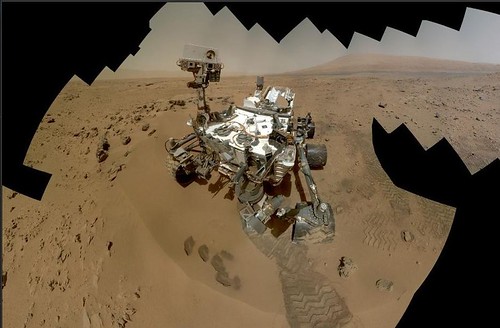Curiosity should have been Time's person of the year

That should have been Time magazine's person of the year: Curiosity, NASA's Mars land rover.
Caption for that photo:
Curiosity Self-Portrait, Wide View
On the 84th and 85th Martian days of the NASA Mars rover Curiosity's mission on Mars (Oct. 31 and Nov. 1, 2012), NASA's Curiosity rover used the Mars Hand Lens Imager (MAHLI) to capture dozens of high-resolution images to be combined into self-portrait images of the rover. This version of the full-color self-portrait includes more of the surrounding terrain than a version produced earlier (PIA16239).The mosaic shows the rover at "Rocknest," the spot in Gale Crater where the mission's first scoop sampling took place. Four scoop scars can be seen in the regolith in front of the rover. A fifth scoop was collected later.
The base of Gale Crater's 3-mile-high (5-kilometer) sedimentary mountain, Mount Sharp, rises on the horizon in the right half of the mosaic. Mountains in the background to the left are the northern wall of Gale Crater. The Martian landscape and the turret on the rover's arm appear inverted within the round, reflective ChemCam instrument at the top of the rover's mast.
The rover's robotic arm is not visible in the mosaic. MAHLI, which took the component images for this mosaic, is mounted on a turret at the end of the arm. Wrist motions and turret rotations on the arm allowed MAHLI to acquire the mosaic's component images. The arm was positioned out of the shot in the images or portions of images used in the mosaic. An animation of the complex choreography the arm used for positioning the camera to take each of the images is at http://www.nasa.gov/multimedia/videogallery/index.html?media_id=156880341 .
Self-portraits like this one document the state of the rover and allow mission engineers to track changes over time, such as dust accumulation and wheel wear. Due to its location on the end of the robotic arm, only MAHLI (among the rover's 17 cameras) is able to image some parts of the craft, including the port-side wheels.
Malin Space Science Systems, San Diego, developed, built and operates MAHLI. NASA's Jet Propulsion Laboratory, Pasadena, Calif., manages the Mars Science Laboratory Project and the mission's Curiosity rover for NASA's Science Mission Directorate in Washington. The rover was designed and assembled at JPL, a division of the California Institute of Technology in Pasadena.
Image credit: NASA/JPL-Caltech/MSSS
Again, that should have been the person of the year.
If we lived in a country that cared about science. If we followed NASA with even 1/10th of the zeal we reserve for 'reality' TV stars. If we gave a damn not only about the world around us but the galaxy and beyond.
Time could have made a statement, they could have encouraged a national discussion on science.
Instead, they went with an easy and embarrassing choice (Barack). Just so they could ass kiss?
Probably so. It's a real shame because we keep hearing how America needs to get better at the sciences. We keep hearing how the sciences will determine our future -- and they mean our economic future.
But time and again, when the media has a chance to talk about science, they find something else to embrace.
And then they wonder why Americans are not stronger in the sciences?
Why bother if it's so meaningless?
If no one cares, why bother?
The media's going to have to get to work on their own little message and they're going to have to start accepting their part of the blame.
Curiosity should have been Time's person of the year.